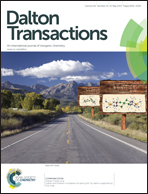Three sra topological lanthanide–organic frameworks built from 2,2′-dimethoxy-4,4′-biphenyldicarboxylic acid†
Abstract
Three 3D lanthanide–organic frameworks (LOFs), [LnL(HCO2)(DMF)]n (Ln = Eu (1), Gd (2), Dy (3); H2L = 2,2′-dimethoxy-4,4′-biphenyldicarboxylic acid), have been prepared by the solvothermal reaction of Ln(NO3)3·6H2O and H2L in DMF–H2O mixed solvent. Crystallographic data show that LOFs 1–3 are isomorphous and crystallize in the orthorhombic space group Pna21. Each Ln(III) is eight-coordinated to four O atoms from four L2− ligands, one O atom from the DMF molecule and three O atoms from HCO2−. The adjacent Ln(III) ions are linked by the carboxylate groups of the L2− ligands and HCO2− to form a 1D inorganic rod-shaped [Ln(CO2)2(HCO2)]n chain as a secondary building unit (SBU). The infinite 1D chains are interconnected by the biphenyl groups, giving rise to a 3D framework along the c axis. LOFs 1–3 are the first neutral Ln-carboxylate/HCO2− chain-based sra-nets. 1 exhibits characteristic luminescence of Eu3+ upon 343 nm excitation. The investigation of magnetic properties shows very weak ferromagnetic interactions (J = 0.0092(3) cm−1) between Gd(III) ions in 2 with a Gd–O–Gd bridging angle of 125.6(1)°, and θ = −1.9(2) K in 3 due to thermal depopulation of the Stark levels of Dy(III) ions and/or the possible antiferromagnetic interactions between Dy(III) ions in contrast to the single-ion behavior observed in 1.


 Please wait while we load your content...
Please wait while we load your content...